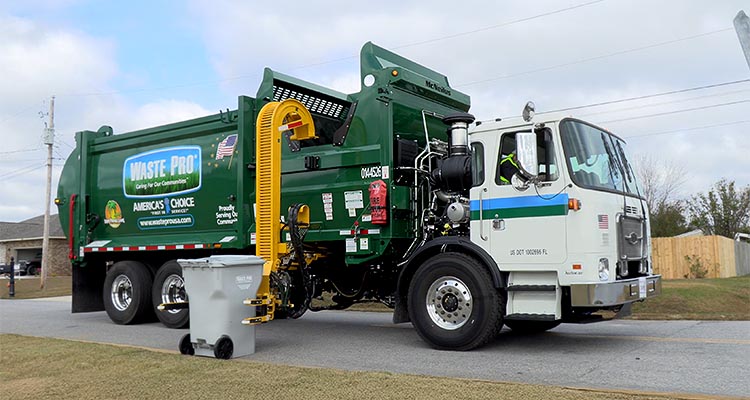Waste Pro USA’s street-level service is setting new standards for garbage collection
Committed to caring for both the environment and the people it serves, Waste Pro USA (Waste Pro) was founded to transform the waste and recycling industry into a value-driven service. By consistently prioritizing personal service, face-to-face contact, and locally sourced vendors, Waste Pro has grown from humble beginnings with just one truck to a leading operator from more than 100 locations across 12 states: Alabama, Arkansas, Florida, Georgia, Kentucky, Louisiana, Mississippi, Missouri, North Carolina, South Carolina, Tennessee, and Texas.
Waste Pro’s vision, to offer a distinguishable difference in the industry, has remained at the heart of the business throughout changing market dynamics and demand for sustainable solutions. To learn more about the business, firstly its history, we sit down with Senior Vice President and COO, Keith Banasiak.

“Waste Pro was initially founded by John Jennings, a first generation American whose father emigrated from Ireland and pursued a career as a garbage collector,” Keith opens. “John initially took a different route, gaining a college degree and working on Wall Street before realizing he wanted something different. He traveled to Florida in 1973 and quickly fell in love with the state. While he was there, he met one of his father’s former colleagues, who was managing a struggling garbage business: Pete’s Garbage Services. They shared experiences and John later purchased the business and began operating it with one truck.
“Over the next 20 years, John built his presence in the central Florida market, rebranding to Jennings Environmental Service in 1992. The company became a first-tier subsidiary of USA Waste Services in Florida in 1996 before being acquired by USA Waste and then becoming Waste Management, at which point John decided to leave the business.
“Around the year 2000, John was receiving several calls from former colleagues and Florida residents complaining about the level of service in the garbage sector,” he narrates. “John was hesitant, but on a university visit to Georgia with his daughter, he saw a Waste Pro vehicle and decided to return to the industry, later purchasing that company and operating our first location in Athens, Georgia.
“John made less than $1000 in the first month, but he continued to propel forward and returned to the Florida market to offer the high level of service customers were longing for. John believed that an equal focus on customers, employees, and trucks was key to delivering top-quality service. Word quickly spread that John was back with a company called Waste Pro, and from there, the business snowballed. Fortunately, I was able to join John in 2005, and he provided me with the resources and trucks to build my own team.
“When I joined, we turned over less than $20 million in annual revenue, and today, we’re on track to turn over around $1.4 billion by the end of the year,” Keith reflects. “The company’s foundation was built on service contracts with cities and governments and servicing highly contracted commercial spaces like grocery stores and shopping plazas, but we then extended to the open market to enable us to build ground-up relationships with additional customers.”
The Waste Pro Way
Fast-forward to today, Keith shares a snapshot of Waste Pro’s current operations. “What’s most important is that we remain a street-level company, delivering services with a distinguishable difference,” he states. “We operate just over 4200 collection trucks, around 15 percent of which are powered by natural gas, and service more than two million residents across more than 260 municipal contracts. We operate 32 landfills, 20 transfer stations, and six recycling facilities for curbside residential recycling.
“Over the last five years, we’ve focused on adding transfer stations to our portfolio to offer an integrated service in terms of flow control. For many states, flow control is managed by a government entity, which typically has a disposal agreement in place, or even owns the disposal location. For instance, in Florida’s Lee County, all waste is directed to a waste-to-energy site as per legislative requirements. This is what we call a complete pass through, where we are paid for the hauling but not the disposal. However, in open markets where the flow is not controlled by government, such as in Louisiana and Mississippi, for instance, our customers are looking for disposal options. As we’re targeting growth in these areas, we can offer a vertically integrated service in open markets by operating and financing our own disposal service.”
One of the key changes throughout Waste Pro’s history is the dramatic evolution of technology. “We’re enhancing our fleet in several ways by implementing AI, and we’re even exploring autonomous operation,” Keith explains. “I recently attended a demonstration where an operator in Florida was controlling a truck in California, and it was a snapshot of how the future could look. I decided to trial an autonomous compactor, as this machinery simply travels back and forth to compact waste and conserve air space at a landfill site. I’m hoping the new machinery will arrive in early 2026, and while we’re not yet envisioning autonomous operations across the board, it will be a good indication of how it could enhance efficiency.
“In terms of AI, we’re using a new system to complete checks on our vehicles, including oil levels, temperatures, and air filter status. Although visual inspections are still important, predictive maintenance using AI means we can keep trucks operational for longer to maximize productivity. With people expecting their waste to be collected on a specific day, time is crucial in our business, and we must protect the fleet to ensure timely operations.
 “We’re implementing new trucks to bridge gaps in our workforce, as it’s no secret that working on garbage trucks is not an easy task. Compared to traditional rear loading garbage trucks, there are more automated vehicles that have an arm to pick up trash cans. These vehicles also have cameras fitted to enable service verification, meaning our municipal partners have access to our daily route progress, providing real-time information for our customers. There’s also AI technology in development that will be able to detect if incorrect or unclean items are in people’s recycling carts. This information can be harnessed to educate customers about effective recycling.
“We’re implementing new trucks to bridge gaps in our workforce, as it’s no secret that working on garbage trucks is not an easy task. Compared to traditional rear loading garbage trucks, there are more automated vehicles that have an arm to pick up trash cans. These vehicles also have cameras fitted to enable service verification, meaning our municipal partners have access to our daily route progress, providing real-time information for our customers. There’s also AI technology in development that will be able to detect if incorrect or unclean items are in people’s recycling carts. This information can be harnessed to educate customers about effective recycling.
“This technology is also helping us to enhance safety,” he adds. “We’re seeing increased numbers of fires in the truck body, which are caused by discarded rechargeable batteries. By installing these cameras in our trucks, we can quickly identify heat sources and alert drivers of thermal issues. Another major cause of incidents in the garbage industry is reversing, so we’ve implemented new cameras in our vehicles and we’re exploring the option of installing sensors that stop the truck if the presence of a person or object is detected.”
On the topic of safety, Keith continues: “Safety is a key component of Waste Pro’s operations, and one that is testament to our distinguishable difference. To encourage drivers to uphold our safety practices, we offer a Driver Safety Award, which is a three-year program that awards drivers without any safety incidents with a $10,000 check. I have one employee who is now working towards his seventh check, and we’re projected to award more than $1.85 million in these rewards just in 2025. We’ve awarded more than $10 million to drivers and helpers, who have their own safety incentive, in the last twenty years. It’s a great achievement for our drivers, and as a privately held company without the constraints of delivering revenue for shareholders, I’d much rather spend money in this way and have our drivers return home safely each day.”
Prioritizing people
Safety is just one aspect of how Waste Pro prioritizes its people. “Waste Pro has run the Co-Heart program, an in-house, DOT-certified CDL training and testing program, out of our facility in Sanford, Florida for ten years. That program has allowed more than 500 employees to earn their CDLs and advance their careers with us as drivers without taking on the prohibitive costs typically associated with CDL training and licensing. After a couple of years of planning, we’ve recently established our own technician training academy at our facility in Sanford,” Keith reveals. “Our two highly skilled trainers conduct two-week programs that consist of both classroom time and practical skills, teaching new hires about our trucks through three key areas: preventive maintenance, brakes, and electrical. Both of these programs are not only a great way for us to cultivate the talent we need, but they’re a good opportunity for personal development. Our people can then progress into B-level, A-level, or even master technicians further down the line through the technician training program, and they can progress from helpers to drivers through the Co-Heart program.”
As our conversation closes, Keith turns to what’s next for Waste Pro. “Our focus in terms of expansion is to create density in the areas in which we operate. Florida, for instance, is a saturated market, and we service around 18-to-20 percent of the state’s total volume. We’re booming in Louisiana, and we’ve recently expanded into Lake Charles, Louisiana, which puts us at the furthest-west point of the state and borders Beaumont, Texas. Although we’re operating trucks in Beaumont, we’d like to establish our own Texas facility by the end of 2025 to consolidate our presence and continue growing in the region.”
It’s clear to see why Waste Pro occupies a leading position in the garbage industry, and by focusing on continuous improvement and investing in its people, the business will inevitably continue to succeed. “I’d like to see Waste Pro hit $2 billion in revenue through a combination of organic growth and strategic acquisitions,” Keith concludes, “but my main priority is to ensure we continue to operate safely and sustainably, delivering a distinguishable difference for our customers.”
